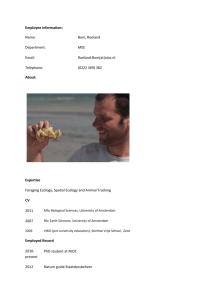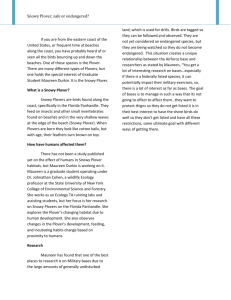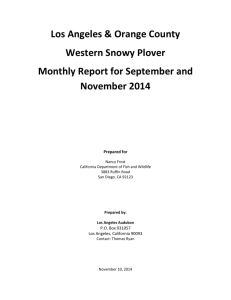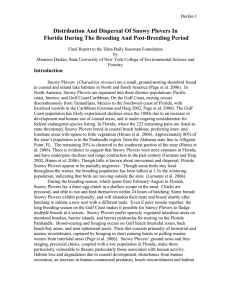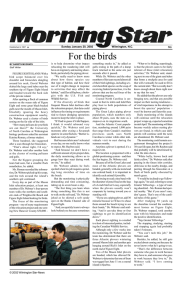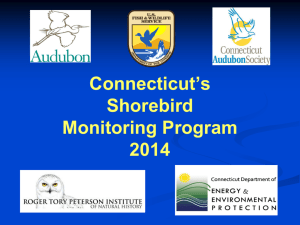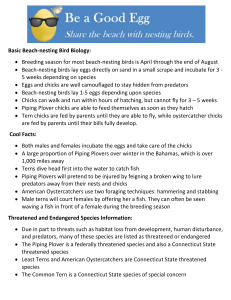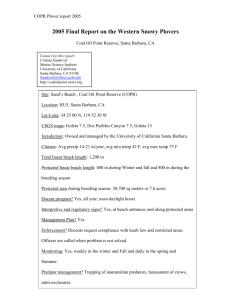Report on Wintering Western Snowy Plovers at Coos Bay North... to Plovers from The North Jetty Repair Project, Winter 2009
advertisement
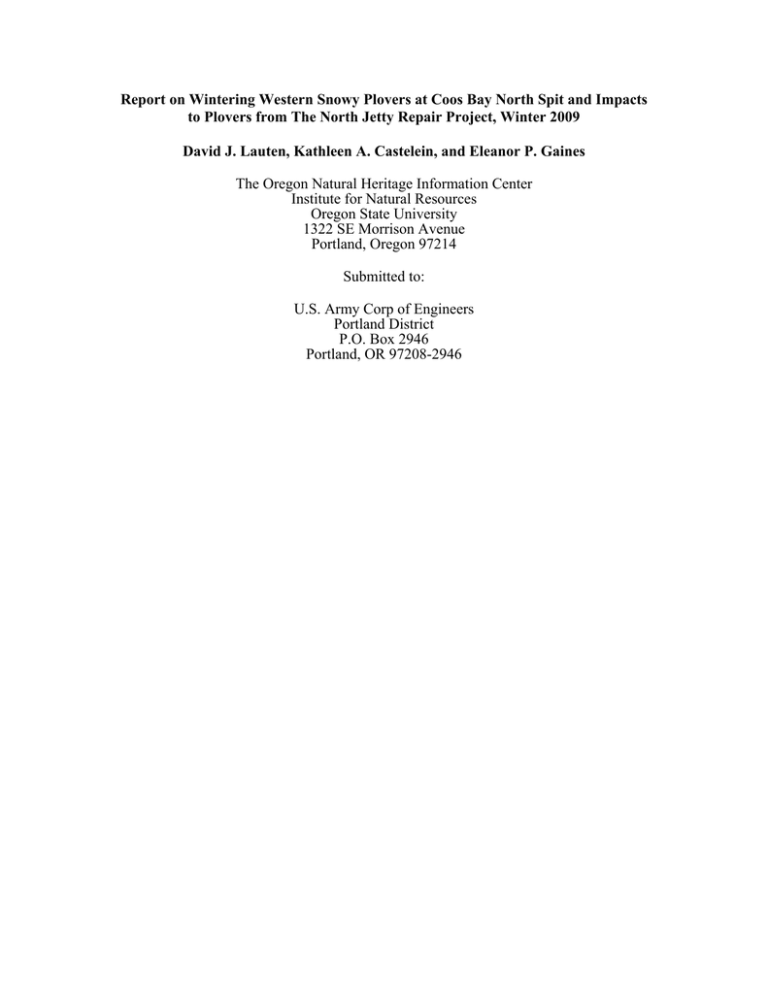
Report on Wintering Western Snowy Plovers at Coos Bay North Spit and Impacts to Plovers from The North Jetty Repair Project, Winter 2009 David J. Lauten, Kathleen A. Castelein, and Eleanor P. Gaines The Oregon Natural Heritage Information Center Institute for Natural Resources Oregon State University 1322 SE Morrison Avenue Portland, Oregon 97214 Submitted to: U.S. Army Corp of Engineers Portland District P.O. Box 2946 Portland, OR 97208-2946 Introduction The Western Snowy Plover (Charadrius alexandrinus nivosus) breeds along the coast of the Pacific Ocean in California, Oregon, and Washington and at alkaline lakes in the interior of the western United States (Page et al. 1991). Loss of habitat, predation pressures, and disturbance have caused the decline of the coastal population of Snowy Plovers and led to the listing of the Pacific Coast Population of Western Snowy Plovers as Threatened on March 5, 1993 (U.S. Fish and Wildlife Service 1993). Oregon Western Snowy Plovers are known to winter along the coast of Oregon as well as migrate to other wintering locations, mainly in California (Lauten et al. 2001, ORNHIC unpublished data). Previous winter surveys along the Oregon coast (Oregon Department of Fish and Wildlife, unpublished data, ORNHIC unpublished data) have documented the locations of wintering Snowy Plovers. Coos Bay North Spit (CBNS) is one location where plovers are known to winter. During the winter of 2008-2009, Army Corp of Engineers (ACOE) contracted Kerr Contractors, Inc. to complete repairs on the North Jetty of the Coos River. ACOE consulted with U.S. Fish and Wildlife Service (USFWS) regarding impacts to sensitive species including Western Snowy Plover. ACOE contracted Oregon Natural Heritage Information Center (ORNHIC) to complete two Snowy Plover surveys prior to jetty repair work, two plover surveys per week during repair work, and two plover surveys post repair work to document any potential impacts to wintering plovers. In winter, plovers tend to spend much of their time roosting along the high tide wrack line, but also spend time foraging, often on the wet sand near the surf (ORHIC, unpublished data). At CBNS, winter Snowy Plover survey data has shown that plovers will roost and feed on the beach north of the North Jetty, but also spend time roosting on the South Spoil and Habitat Restoration Areas (HRAs) east of the foredune. Large 20ton dump trucks and other large equipment were used to haul material to the North Jetty. Vehicles used the foredune road that bisects the HRAs. Our objectives were to survey and monitor Snowy Plovers on the beach, HRAs, and South Spoil, to document the number of plovers using the area and any impacts or disturbance to the plovers during the North Jetty repair project. Methods We surveyed the beach at CBNS from the FAA towers to the North Jetty (ca. 3 miles) using an ATV and “leap-frogging” survey method. “Leap-frogging” entails one person walking along the wrack line while a second surveyor drives the ATV several hundred meters ahead, then parks and continues to walk. Then the first individual moves the ATV forward, “leap-frogging” ahead of the other person. This is repeated for the length of the beach. All plovers that were observed on the beach were viewed with a spotting scope to determine if they had color bands or were unbanded. If they were banded the combination was recorded. We then drove on the foredune road to the HRAs and South Spoil, and we walked through the HRAs and South Spoil, looking for roosting plovers. All plovers were again scoped and all color band combinations were recorded. 1 We divided the areas we surveyed into three separate areas: South Beach, the open beach from the FAA towers to the North Jetty; the 95HRA, the habitat restoration area west of the foredune road; and the 94HRA/South Spoil, the large habitat restoration area on the east side of the foredune road that included the 94HRA, the South Spoil, and the 98EHRA. We calculated mean number of plovers seen on each survey area, and the standard deviation. Since we have only occasionally surveyed plovers during the winter time period (except for the annual one day survey conducted every winter in January), we also noted some aspects of plover biology, particularly arriving spring migrants and behavior of wintering plovers. We also commented on whether we recorded any observable disturbance to the plovers by vehicles using the foredune road and general jetty repair work. Results We conducted our first survey on 10 January 2009 and our last survey on 10 March 2009 (n = 14, Table 1). The timing of these surveys was based on the jetty repair schedule. Construction work began on 23 January 2009 and was completed by 2 March 2009. On South Beach, we recorded a mean of 5.79 plovers, and had a range of 0 – 16 plovers. On the 95HRA, we recorded a mean of 0.21 plovers, and had a range of 0 – 3 plovers. On the South Spoil/94HRA, we recorded a mean of 8.50 plovers and a range of 0 – 21 plovers. On South Beach, we recorded plovers on half the surveys conducted. On the 95HRA, we recorded plovers only once, on 2 March. On the South Spoil/94HRA, we recorded plovers on 86% of the surveys. A total of 26 individual plovers were recorded (Table 2). Twenty-three of these plovers had some bands, either a single federal band or some combination of color bands and federal band. Three plovers were unbanded. Thirteen of the plovers were males, and 10 plovers were females. The three unbanded plovers were all believed to be females. Of the 26 individual plovers, 12 were actually wintering birds. These twelve plovers were recorded in fall time through mid November at CBNS, and continued to be present through March. The other 14 plovers wintered at some other location. The first migrant to appear occurred on 17 February, and all surveys after 17 February had newly arriving migrant plovers except on 6 March when we did not record any new migrant plovers. When surveying South Beach, we did not see any plovers north of the Olson wreck, which is approximately one mile north of the North Jetty. Plovers were recorded on South Beach mostly due west of the south end of the 95HRA south to the area just north of the North Jetty. Plovers were typically encountered either roosting in the wrack line, or feeding on the wet sand and near the water. On the South Spoil/94HRA, we found the plovers roosting mainly on the South Spoil, several hundred meters east of the foredune road. We generally did not find plovers roosting on the 94HRA or the 98EHRA, however, late in February and into March some plovers would occasionally be found on the 94HRA. We only found plovers on the 95HRA once, on 2 March. These 2 three plovers were roosting in the newly spread shell hash area (300 cubic yards spread in fall 2008). We did note nest scraping by plovers as early as 20 February. We did not track numbers of other shorebirds, however, we did note that Sanderling (Calidris alba), Dunlin (C. alpine), Western Sandpiper (C. mauri), and Least Sandpiper (C. pusilla) all wintered at CBNS. These four species were seen in relatively large flocks (hundreds of individuals) on South Beach, and also used the newly spread shell hash area on the 95HRA as a roosting location. Large flocks of shorebirds were regularly observed roosting on the shell hash area of the 95HRA, especially at high tide. Discussion CBNS has been a known wintering plover site (Lauten et al. 2001, ORNHIC unpublished data), but has not had wintering flocks as large as some other Oregon coastal areas. Typically, CBNS has had less than 20 plovers wintering, and often less than 10. Other Oregon wintering areas, such as Bandon/New River, Tenmile, and Siltcoos, have had 40 or more wintering plovers. Twelve plovers were recorded regularly during winter 2008-09, which was fairly typical of CBNS. Plovers consistently used South Beach and the South Spoil as roosting locations. Plovers frequent South Beach because it is the source of food resources, as the HRAs and spoil do not harbor large invertebrate resources during winter. Plovers need to utilize the beach to obtain food. Plovers were noted in the wrack line feeding, but more often forage on the wet sand where winter food resources are more abundant. Plovers used the South Spoil to roost. The South Spoil is a safe haven during high tides and storms, and due to the relative remoteness of the area, as well as the lack of human activity, the South Spoil is a safe refuge for the plovers when they are not foraging. Plovers using the beach were not likely disturbed by North Jetty repair activity. Hauling by trucks had no impact on plovers using the beach, and while plovers were found several hundred meters north of the North Jetty, plovers were never found near the jetty or within proximity of jetty repair work, either before, during or after repair work. Plovers roosting on the HRA could have been within 50 meters or less of the foredune road and could have been disturbed by hauling trucks. However, we never found plovers anywhere near the foredune road, and plovers were consistently found on the South Spoil, well away from the road. Plovers roosting on the South Spoil showed no signs of any disturbance, even during active hauling. It is possible that plovers were using the spoil instead of the HRAs to roost due to hauling activity, but this is not likely the case as we consistently found the plovers on the South Spoil when hauling was not occurring. We found plovers roosting regularly on the spoil in fall 2008 before any repair activity started, and hauling actually only occurred on a handful of days, yet plovers were consistently found roosting on the spoil. Therefore we have no evidence nor do we think that plovers were roosting on the spoil due to disturbance. Furthermore, the relatively hard packed shell hash of the spoil, in conjunction with the general lack of disking of the spoil, results in good roosting habitat for the plovers. During windy and stormy weather, 3 the spoil does not have as much blowing sand and offers plovers good sheltered areas to roost safely, so it is likely the plovers prefer this area for roosting due to these factors more than the actual proximity to the foredune road. On the 95HRA, we consistently noted large shorebird flocks (mostly Least and Western Sandpipers, and Dunlin) roosting on the new shell hash area (the BLM spread 300 cubic yards of shell hash in fall 2008). This area was within 15 meters of the foredune road. We did not note any disturbance to these shorebirds by foredune road use. The shell hash area sits slightly higher than the foredune road, and is blocked from direct view by the berm along the foredune road. Shorebirds did not respond in any manner to vehicles traveling by, further suggesting that hauling trucks did not cause any disturbance to shorebirds. Surveying plovers during a time of year for which we have little data (mid to late winter), allowed us for the first time to witness returning migrant plovers. We had no data concerning the timing or the number of birds returning to breeding areas. The first migrant plover arrived 17 February, and one or two newly arrived migrant plovers were recorded on most dates after 17 February. We also recorded pair bonding and nest scraping as early as 20 February. By early March we recorded over 20 plovers at CBNS. This indicates that plovers begin migration as early as mid-February and begin to show immediate signs of breeding behavior (i.e. nest scraping). This data helps to clarify when plover behavior starts to change from wintering to breeding, and helps to establish a timeline for any type of human related work in and around Snowy Plover wintering and breeding areas. We would recommend that consideration of these behaviors be taken into account when planning future projects, whether projects related to jetty repair or other management projects such as plover habitat improvements or general habitat management around the nesting areas. Acknowledgements We like to thank Steve Helm and Jeff Edwards of ACOE; the numerous Kerr Contractors employees who helped us with access and information; Steve Langenstein of Coos Bay BLM; and Laura Todd and Liz Kelly at USFWS. Literature Cited Lauten, D.J., M.A. Stern, and K.A. Castelein. 2001. Snowy Plover distribution and abundance along the Oregon coast in winter 1990 – 2000, with an assessment of oiled plovers from the New Carissa incident. Page, G.W., L.E. Stenzel, W.D. Shuford, and C.R. Bruce. 1991. Distribution and abundance of the snowy plover on its western North American breeding grounds. J. Field Ornithol. 62:245-255. 4 U.S. Fish and Wildlife Service. 1993. Final rule. Endangered and threatened wildlife and plants; Determination of threatened status for the Pacific coast population of the western snowy plover. Federal Register 58 FR 12864 03/05/93. 5 Table 1. Date and number of Snowy Plovers on surveys of three areas of Coos Bay North Spit, Jan - March 2009. Date 10-Jan 20-Jan 22-Jan 26-Jan 29-Jan 1-Feb 12-Feb 14-Feb 17-Feb 20-Feb 26-Feb 2-Mar 6-Mar 10-Mar mean SD % of surveys with plovers South Spoil/94HRA South Beach 95HRA # of plovers # of plovers # of plovers 0 0 10 10 0 2 0 0 10 12 0 0 0 0 11 12 0 0 0 0 14 0 0 14 0 0 10 16 0 2 13 0 7 12 3 6 6 0 12 0 0 21 5.79 0.21 8.50 6.35 0.80 6.07 50% 7% 86% Construction period 6 Table 2. Snowy Plover color band combinations, sex, and date first seen during winter surveys at CBNS, Jan - Mar 2009. Color Combo Sex BR:AB F BR:BB M BR:YG M G/B/G:N M G/O/G:N M G:B F GR:WY F GW:GB M GW:LW F GW:WB M GW:WR M LB:WG F LR:GB M LS:WR F R/W/R:W F RS:RB M RS:YG M S:B M S:B F S:X M S:X F VW:GR F X:X F? X:X F? X:X F? Y/W:N M Date first seen 17-Feb 10-Mar 2-Mar 20-Jan 20-Jan 29-Jan 10-Mar 10-Jan 10-Jan 10-Mar 26-Feb 20-Feb 20-Feb 20-Jan 10-Jan 10-Mar 12-Feb 2-Mar 10-Jan 10-Jan 26-Feb 26-Feb 10-Jan 10-Jan 10-Jan 20-Jan Comments wintered wintered only date seen wintered wintered wintered wintered wintered wintered wintered wintered wintered wintered 12 plovers were wintering at CBNS during winter 2008-09. Date of first migrant: 17 Feb 7
